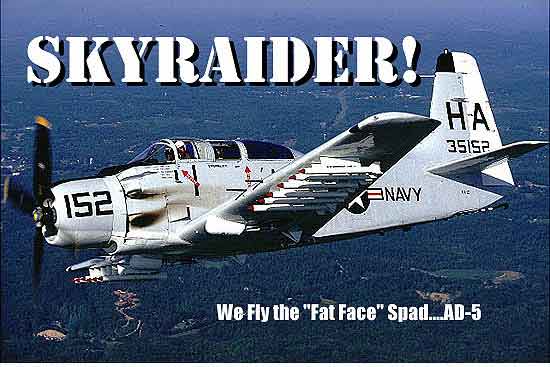 |
AD-5 Skyraider: Dipping
into the Horsepower Pool |
PAGE TWO The Skyraider is one of those airplanes which has been unfairly over shadowed by the high flying, fast movers. History seems to bestow glory on higher profile airplanes first. The Skyraider is an easy airplane to miss because it has always been a down in the weeds mud fighter. It is the aerial cousin to the rifle toting grunt fighting his way through a world of foxholes and muck. Originally conceived as a replacement for the Navy's Dauntless dive-bomber, the Skyraider was the direct result of what the Navy learned in the Pacific. They wanted a carrier based, single-engine airplane that could carry a monstrous load of ordnance. Equally as important, the ordnance load had to be variable from station to station down the wings. They wanted to put an airplane over the combat zone that in a single mission could selectively pound positions with rockets, bombs, napalm and anything else they could think of to hang under it. The winner of that 1944 design contest, the Douglas AD-1 Skyraider, met its goals and went far beyond. The airplane first flew on March 18th, 1945 and, where most of its brethren which were also born on the eve of war's end were to see tragically short service lives, the Skyraider soldiered on for nearly twenty years and two wars. By the time production stopped in 1957 over 3,180 Skyraiders of at least seven different variations rolled off the lines.

The Skyraider was a wonderful conglomeration of firsts, lasts and biggests. For instance, it was the last heavy single engine airplane built for the Navy. It carried an ordnance load nearly half again larger than a B-17, 7,500 pounds versus 4,800 pounds. It carried enough varied ordnance that it could make over 100 passes on a single sortie. The 2,700 horsepower Wright R-3350, same as used on a B-29, was the second largest engine ever hung on a production US military airplane and was the largest used on a single-engine, long production airframe. It was also, quite probably, the slowest airplane the US ever fielded for the horsepower, which was also one of its strong points. Gross weight cruise while on a mission might be as slow as 120 knots, although it could be, and was, dived to over 300 knots. It was it's slow speed which allowed its pilot to put the ordnance exactly where it counted. He motored down towards the enemy at near-Piper Cub speeds into that hazardous altitude where even rifle bullets were a serious threat. In Korea, the Skyraider's mission was ground support. Find the bad guys and ruin their day. In Viet Nam, where the Skyraider really came into it's own, its most important mission was Search and Rescue. Get out there where one of our guys needed help and keep Charley at a distance until the helo's arrived. Then they stayed on station, laying smoke, napalm, rockets and 20 mm down to cover the rescue. As Vietnam wore on, the role played by the AD was shifted almost entirely over to the USAF pilots who earned a big niche in the memories of all service pilots because of the terrific work they did in the Sandy role. More than one USAF pilot came back with foliage in his hard points and holes in his airplane while doing their best to keep Charlie away from one of their own. More than one USAF pilot didn't come back from Sandy missions. Beginning in 1962, when inter service designations changed, the AD-1 through AD-7 became A-1A through A-1J with a bewildering number of other variations in between. In it's last war, however, whatever it's official designation, it was usually known as Spad or Sandy, when used as top cover for recovery operations, its most famous role.
|